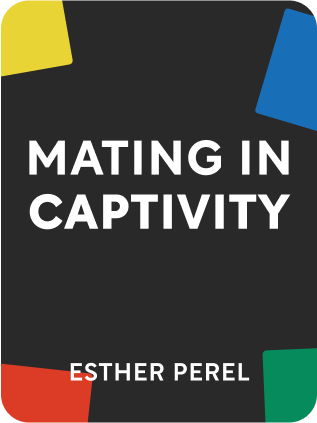

This article is an excerpt from the Shortform book guide to "Mating in Captivity" by Esther Perel. Shortform has the world's best summaries and analyses of books you should be reading.
Like this article? Sign up for a free trial here .
What is Esther Perel’s Mating in Captivity about? What is the key message of the book?
Mating in Captivity looks at what makes up our individual sense of desire and our desire for our partners. According to author Esther Perel, although desire and love may have some fundamental contradictions, there are ways to balance the clashes, and ways to manage extra-relationship stresses.
Below is a brief overview of Mating in Captivity by Esther Perel.
Mating in Captivity: Unlocking Erotic Intelligence
According to most people and sources, modern couples are having less sex even though they have more sexual freedom than any generation that’s come before them. Now that it’s socially acceptable to have sex outside of marriage and we can do so without the threat of pregnancy, apparently, we’re not interested. It could be that we’re busy, stressed, tired, or overwhelmed by parenthood.
Or, it could be that modern domesticity and sexuality are an either/or situation—can we actually have both? Modern domesticity is associated with things like security, intimacy, and egalitarianism, while desire is concerned with things like play, aggression, jealousy, and risk. Even though domesticity and desire seem to be made up of contradictory ingredients, the author of Mating in Captivity, experienced couples therapist Esther Perel, believes it’s possible to retain desire in a committed relationship.
Here is a quick summary of the key points from Mating in Captivity by Esther Perel.
Individual Desire
First, let’s look at what shapes our desire. While desire is made up of the same general ingredients for everyone, everyone’s individual desire is different, as it’s influenced by our upbringing and personalities.
Family
From the moment we’re born, we start learning about relationships from our families. We learn how to show affection, express ourselves, and interact with others, and we carry what we’ve learned into adulthood.
The first major element we carry forward is our relationship with dependence and independence. We depend on our parents and we do everything we can to stay close to them, but we also need our independence. We’ll experience this same tension with our partners later in life, and we’ll react to it the same way we learned in our childhoods.
- Example #1—Unhealthy Response: When Dylan’s mother died, he learned he couldn’t turn to his father for emotional support—he was on his own. As an adult, Dylan pursues anonymous, unemotional sex because he learned that relying on others was shameful.
- Example #2—Healthy Response: Makena’s mother and father locked themselves in their bedroom for a couple hours every Saturday afternoon. If Makena wanted a snack on a Saturday afternoon, she had to wait or get it herself. As an adult, Makena can emotionally connect with her partner during sex, but she’s also comfortable temporarily focusing on herself and her own pleasure.
The second major element is our views about sexuality. If our parents were open about sex, we’ll likely also be open. If our families thought sex was shameful, we’ll pick up this connotation too.
The last major element is how our gender tempers our expression of our sexuality. We’re exposed to gender stereotypes and expectations from the moment we’re born. When girls grow up into women, they sometimes have trouble owning their sexuality and base it on whether or not others desire them. When boys grow up into men, their desire debatably falls into two categories—those who want their partner to initiate to confirm their own desirability, and those who are uncomfortable with their partner initiating because it makes them feel passive, and therefore unmanly.
Fantasy
A fantasy is no more or no less than a mental exercise in creating desire. In spite of the negative reputation fantasies once had with the church and psychology, science now acknowledges that fantasies are a healthy part of adult sexuality. They help us figure out what we want—but not in the way you think.
Unlike daydreams or other fantasies, sexual fantasies are metaphorical rather than literal. If you’re daydreaming about cake, you probably do want cake. If you fantasize about being a high-priced prostitute, you may not literally want to be a high-priced prostitute. Instead, what this fantasy might reveal about you is that you want to be desired. If people are willing to pay a lot of money to sleep with you, you know you’re wanted and valued.
You can share your fantasies or you can keep them to yourself. Either way, remembering that fantasies are a non-literal expression of self can help you learn about your sexuality without shame.
Desire within Our Relationships
Next, let’s consider desire for our partners specifically. It’s normal for desire to fade, or wax and wane, in a committed relationship. Balancing love and eroticism isn’t something we can do perfectly all the time, and a committed relationship gives us time to practice and play.
When we’ve decided it’s time to bring back desire, there are two ways to approach this: quantitatively and qualitatively. American culture tends to be big on the quantitative approach, which includes measuring the frequency and duration of sex, and medical intervention such as Viagra if necessary. However, the can-do attitude and emphasis on hard work that works well in other arenas don’t necessarily lend themselves to the subjectiveness of desire.
Mating in Captivity defines eroticism, or desire, as sex with imagination, and looks at the qualitative aspects of desire rather than stats. Imagination is made up of intangibles such as creativity, playfulness, and curiosity. In a sexual context, these intangibles tangle with longing and transform. The ingredients for desire become intangibles such as mystery, uncertainty, and aggression.
There are two types of tensions that make it hard to maintain desire in committed relationships: inherent tensions between the values of domesticity and desire, and external tensions between a couple and the rest of the world.
Tension #1: Inherent Forces
The values of long term relationships—commitment, intimacy, and egalitarianism—are at odds with some of the fundamental ingredients for desire—risk, distance, and power imbalances. The balance often lies in looking at your partner in a new context.
The author discusses three specific sets of conflicting values:
- Commitment vs. excitement
- Intimacy vs. mystery
- Egalitarianism vs. power imbalances
Commitment vs. Excitement
Commitment, and the security it brings, is a wonderful thing in a long-term relationship. You don’t have to worry about if your partner loves you or if your relationship might crash and burn at any moment. However, security has a deadening effect on desire. Fear of losing your partner was part of what made the relationship exciting.
To balance commitment and desire, change your perception of your partner. They might be committed to you, but they’re their own person, and you don’t own them. Look at them in a different context to your partnership. For example, the next time you’re at an event with your partner, imagine how everyone else in the room sees them—as someone unknown to be curious about—and try to see them that way too.
Intimacy vs. Mystery
Knowing someone well is comfortable, and intimacy is a fundamental human need. However, desire requires distance because when two people are so fused they’re one, there’s no mystery, and no person separate from yourself for you to fall in love with. Many people would be unwilling to give up the closeness of a stable, long-term relationship for the distance required by desire.
To balance intimacy and desire, create either psychological or physical distance. Like balancing commitment and desire, you can try to change your perception of your partner. You might think you know everything about them, but it’s impossible to fully understand another individual, and simply acknowledging this can increase your psychological distance and increase desire. More literally, you can spend less time in close proximity to your partner, whether that’s leaving them alone when you’re home together, or one of you moving out.
Egalitarianism vs. Power Imbalances
Modern committed relationships value egalitarianism, partnership, and democracy, but desire fundamentally thrives on the conflicting intangibles of risk, aggression, and power imbalances. However, unlike commitment and intimacy, you don’t have to balance egalitarianism with desire—in the compartmentalized space of the bedroom, as long as things are consensual, one partner can take control of the other to increase desire. Egalitarianism may feel like a value inherent to love, but it’s actually more cultural. Latin Americans and Europeans don’t insist on egalitarianism in the bedroom the same way that Americans do.
The author recommends abandoning egalitarian only in the consensual, compartmentalized, erotic space. Maintain egalitarianism in other aspects of the relationship.
Tension #2: Outside Forces
Mating in Captivity discusses four forces outside a relationship that can have a detrimental effect on desire: defaulting to talk as the main language of intimacy, mixed cultural messages, parenthood, and infidelity.
Talk Intimacy
In modern times, talking has become the default language for intimacy. This is due to the female influence on modern relationships. As women became more economically independent, they wanted more from their relationships than being financially provided for—they wanted emotional connection too. And because women are socialized to be good at verbal communication, they build (and expect men to build) intimacy by talking.
Men, however, have been socialized to take a more physical approach when expressing themselves. They’re often more comfortable developing intimacy through non-verbal communication, for example, through touch or sex.
If you communicate verbally and your partner non-verbally, or vice versa, first, acknowledge that there’s more than one way to create intimacy. Then, try learning to speak each other’s languages in a non-sexual context first.
Mixed Cultural Messages
American culture sends out mixed messages about sex. The media encourages us to have it however and whenever we want, especially outside of relationships. Puritan legacy suggests that it’s only acceptable within heterosexual marriage, and it’s only for making babies—if you’re having fun, you’re doing it wrong and it’s shameful.
To navigate all these mixed messages, remember that sex can be whatever you and your partner want it to be. Shame is a cultural construct, not an inherent quality of sex. Being open and validating each other can help reduce shame.
Parenting
Having a baby changes everything about a couples’ life. Time, imagination, and energy that they could previously spend on each other must now be shared with a child. Additionally, there are cultural messages about parenthood that affect desire, such as that mothers are sacred and selfless, and it’s inappropriate to lust after something so pure. For example, after Leo’s wife Carla gave birth, he could no longer see her as a lover or wife, only as a mother. He thought it was weird to suck the same breasts his children did.
Rekindling desire as parents involves making time to be together, letting go of the responsibility and selflessness you direct at your children, and not letting cultural messages constrain you. For example, Carla charged Leo $100 for a blow job. That’s not something a mother would typically do, so it helped him de-role her.
Infidelity
Every relationship has a “third,” a term the author uses to describe the potential for infidelity. The third can be an actual person, a fantasy, or an aspect of the life you would have had if you hadn’t chosen to be with your partner. There is a third in every relationship, because fidelity wouldn’t mean anything if it was the only option.
You and your partner can approach the third in three ways: as a threat to be ignored, a possibility to acknowledge, or an act to do.
Ignoring the third doesn’t usually turn out well—it can result in stifling boredom that encourages one person to look outside the relationship for excitement. (Affairs tend to be exciting because they’re heavy on the ingredients of desire, such as risk and jealousy.)
Acknowledging the third has a lot of leeway. You and your partner can simply acknowledge that it exists, or you can play with it, for example, by allowing each other to flirt with others but go no further.
Finally, acting on the third means opening up the relationship to nonmonogamy. Fidelity becomes emotional rather than physical. Open relationships can create desire for the original couple as well as the third—when your partner goes after someone else, they’re individual and mysterious, and there’s distance between you and them.
Regardless of how you and your partner choose to handle the third, it’s important to cultivate distance, mystery, and risk in your relationship to maintain desire.

———End of Preview———
Like what you just read? Read the rest of the world's best book summary and analysis of Esther Perel's "Mating in Captivity" at Shortform .
Here's what you'll find in our full Mating in Captivity summary :
- Why it's difficult to have a good, erotic life within a long-term relationship
- What makes up our individual sense of desire and our desire for our partners
- Tips on how to retain desire in a committed relationship






